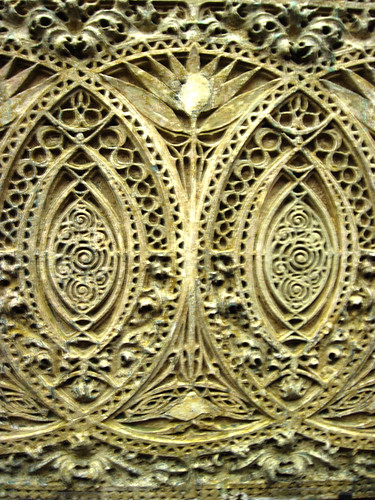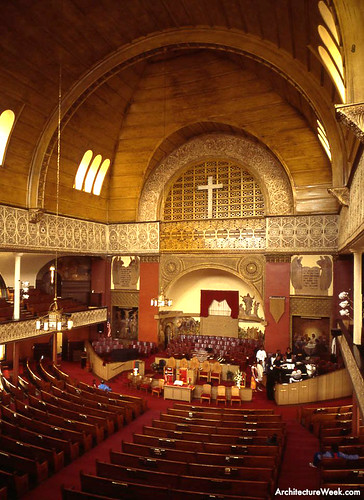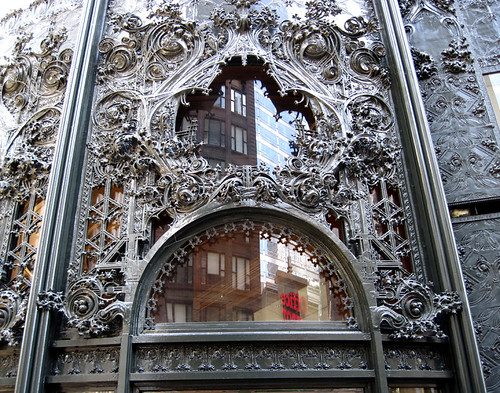As a native Chicagoan, I had always heard about the great Chicago architectural firms from the late 1800's through the early 20th century. The firm of
was the one that made the biggest impression on me.
I recently went to the
Chicago Cultural Center for their new "
Louis Sullivan's Idea" exhibit. It features fragments of the magnificent ornamentation salvaged from buildings designed by Sullivan. The exhibit walks the visitor through the life of this famous architect, from his arrival in Chicago in 1873, to his death in 1924.
Louis H. Sullivan in 1899
Louis H. Sullivan came to Chicago from Boston. He partnered with Dankmar Adler in 1879. That partnership lasted until 1895. Both the Adler & Sullivan team, then Sullivan alone, created some of the most influential buildings in American history.
Wainwright Building, St. Louis, MO, 1890-91
I walked in awe among the fragments of terra cotta and ironwork, toughing each as I came upon them.


Pilgrim Baptist Church, Chicago, 1891. Destroyed by fire in 2006.
The exhibit is enhanced by enlarged photographs, some reaching 24 feet tall. The fragments were put into their proper context by finding their placement in the photos.
Auditorium Theatre, Chicago, 1889
Auditorium Theatre, Chicago, 1889
part of a door in the Auditorium Hotel
Walking the streets of downtown Chicago, it's hard to look up or to get a close look of what remains of Louis Sullivan's work, or most any of the late 19th and early 20th century buildings. There are so many more modern, much taller structures looming over everything.
This exhibit brings all the details down to eye-level, like you'd never see it on the actual buildings. The fact that the curators allow you to touch the pieces makes the experience even more special.
Schiller Building wall stencil, Chicago 1890-92.
Louis Sullivan was a believer in bringing natural, organic forms to the tall, otherwise impersonal skyscrapers that he and his contemporaries were designing. I thought the pieces were beautiful. I wish I could have seen these buildings in all their original splendor. Sadly, most have been torn down or modernized beyond recognition.
Transportation Building, World's Columbian Exposition, Chicago, 1893
Sullivan's
Transportation Building at the Chicago World's Columbian Exposition of 1893 was the only building not conforming to the all-white Beaux-Arts style in
Daniel Burnham's plan for the White City.
Chicago Stock Exchange, Chicago, 1894
Chicago Stock Exchange, entrance salvaged & on display at the Art Institute of Chicago
detail of Chicago Stock Exchange entrance.
While attending college years ago at the Art Institute of Chicago, I would gaze upon the salvaged Chicago Stock Exchange entrance arch, on display outside the school. When I graduated, the reception was held in the reconstructed
Chicago Stock Exchange trading floor.
Chicago Stock Exchange Trading Room, reconstructed at the Art Institute of Chicago.
sculptors working on Sullivan's details
A few of Sullivan's Chicago buildings remain. The old
Carson Pirie Scott store (originally the Schlesinger & Mayer store) is being restored. The
Auditorium Theatre is restored and is operated by Roosevelt University.
original Schlesinger & Mayer facade, 1899
original Schlesinger & Mayer facade, 1899
Whenever I used to meet up with somebody downtown, we would meet at the Carson Pirie Scott corner doorway, under that magnificent ironwork!
old Carson Pirie Scott store as it looks today

detail of old Carson Pirie Scott storefront today
original Schlesinger & Mayer facade piece
original Schlesinger & Mayer baluster piece
After 1900, the fanciful style that made Sullivan famous was falling out of favor. His high profile commissions went away. He continued to work, however, on smaller buildings in the midwest. Some of his unique banks remain to this day.
detail from National Farmers' Bank, Owatanna, MN, 1908
clock from National Farmers' Bank, Owatanna, MN, 1908